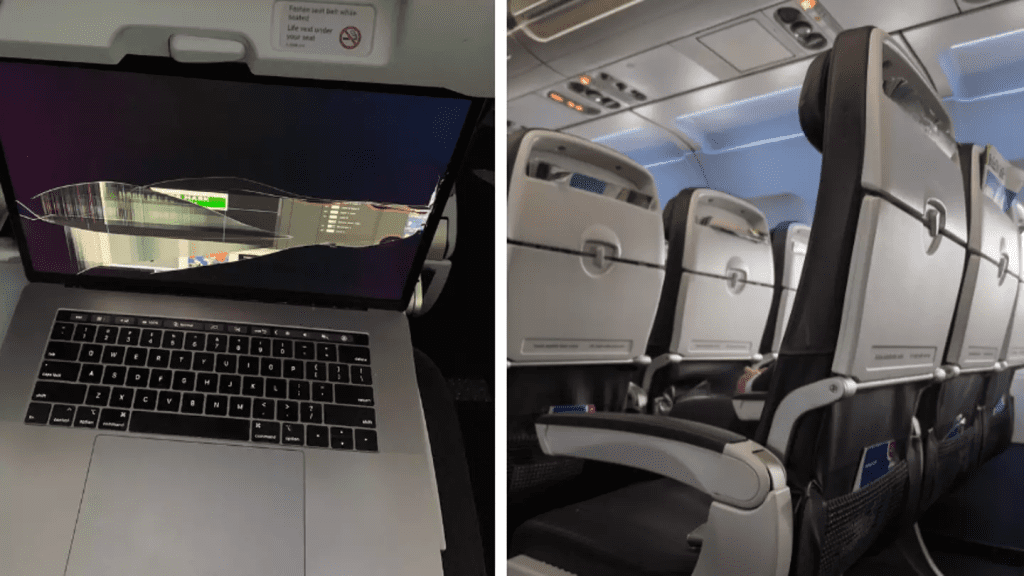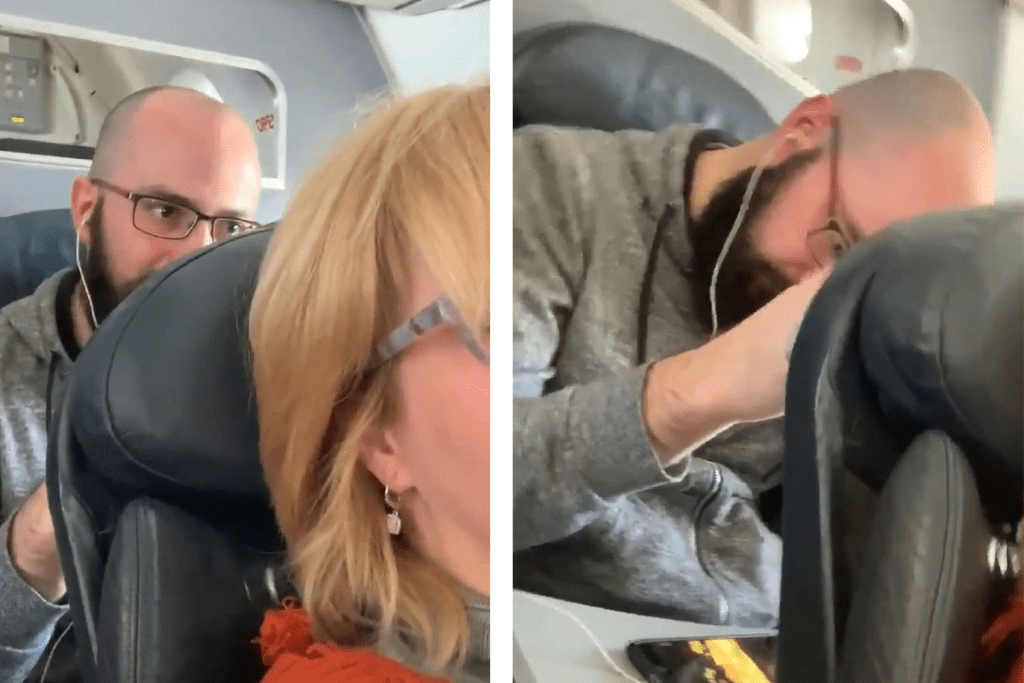The great debate over reclining airplane seats has resurfaced, fueled by a recent incident that left one Delta Airlines passenger with a shattered laptop screen. Pat Cassidy, a 37-year-old film producer and podcast host, found himself at the center of the controversy after his MacBook screen was destroyed mid-flight when the passenger in front of him reclined their seat. Cassidy’s experience has reignited the long-standing question: Should passengers still have the right to recline, or is it time to do away with reclining seats altogether?
The Reclining Seat Dilemma: A Costly Mistake

Cassidy’s flight experience took an unfortunate turn when the passenger seated in front of him reclined their chair, causing his laptop—perched on the tray table—to be crushed. Sharing his frustration on Twitter, Cassidy posted a photo of the shattered screen, expressing his disbelief over the lack of precautionary measures by airlines to prevent such accidents. “Maybe have a little warning sign or some way to prevent my laptop from being destroyed when the person in front of me reclines their seat,” he tweeted.
His situation didn’t end there. Cassidy’s frustration only grew when a Delta flight attendant, instead of addressing the damage done to his laptop, inquired whether the passenger in front was “okay” after reclining. Cassidy’s second tweet echoed his irritation: “I really appreciate that your flight attendant… asked if he was okay, as if your seat hadn’t just ruined my livelihood.”
The response from Delta Airlines was, by all accounts, less than satisfactory, as Cassidy later updated his followers that the airline hadn’t offered a replacement laptop or even issued a warning to other passengers about the risks associated with reclining seats.
Is It Time to Rethink Reclining Seats on Planes?
Cassidy’s experience sparked a flurry of responses on social media, with many users taking sides in the ongoing debate over the etiquette—and necessity—of reclining seats on airplanes. One Twitter user commented, “The whole seating system in airlines needs to be disrupted. Rethought. Better.” Another agreed, stating, “This is my biggest travel pet peeve. I think it’s rude to recline your seat.”
While some argue that reclining is an inherent right that comes with the seat, others feel it’s an outdated feature that does more harm than good. The debate isn’t just about personal space and comfort—it’s about how airlines design their seating arrangements, which seem to be increasingly packed and uncomfortable for modern travelers.
Delta Airlines CEO Weighs In on Reclining Etiquette
Delta Airlines CEO Ed Bastian has previously addressed this contentious issue. In a 2020 interview with CNBC, Bastian commented on what he believes is the proper etiquette when it comes to reclining on a plane. “I think customers have a right to recline,” Bastian said. However, he also emphasized the importance of common courtesy, adding, “The proper thing to do is if you’re going to recline into somebody, you ask if it’s OK first.”
Despite acknowledging that passengers have the right to recline, Bastian revealed that he personally never does. As the CEO of Delta, he chooses not to recline out of respect for those seated behind him, noting that he wouldn’t want to inconvenience them. Bastian’s approach suggests that while reclining is a personal choice, it’s one that should be made with consideration for others—an idea that’s lost on many travelers.
The Decline of Reclining Seats: A Growing Trend

Interestingly, the trend of reclining airplane seats has been on the decline. According to CNN, more airlines are opting for non-reclining seats in their aircraft designs, particularly for short-haul flights. The reasoning? Cost, weight, and simplicity.
German seat maker Recaro, a major supplier of airline seats, has been leading the charge in developing pre-reclined seating. Mark Hiller, Recaro’s CEO, highlighted the advantages of this design: “The main advantage is increased living space, as a passenger’s living space is not intruded by recline.” Pre-reclined seats provide a fixed tilt that offers some comfort while eliminating the need for moveable parts, which are prone to wear and tear.
Pre-reclined seats not only help improve comfort for all passengers but also reduce costs for airlines. The simpler design means fewer parts that can break, leading to reduced maintenance. Additionally, removing the recline feature lowers the overall weight of the aircraft, a key factor in reducing fuel consumption—a crucial cost-saving measure for airlines.
The Economic Benefits of Non-Reclining Seats
Airline economics play a significant role in the push for non-reclining seats. The average airplane seat weighs between 15 and 22 pounds, and any reduction in seat weight can result in lower fuel costs. By eliminating the reclining mechanism, airlines save on manufacturing costs and reduce the overall weight of the plane, allowing for more efficient operation.
Recaro’s pre-reclined seats have gained popularity not only for short-haul flights but also for low-cost carriers, where maximizing space and reducing weight are top priorities. As airlines continue to face pressure to cut costs, it’s likely that more will follow suit, leaving reclining seats behind in favor of fixed, pre-reclined alternatives.
Should Reclining Seats Be a Thing of the Past?

Pat Cassidy’s broken laptop is just one example of the inconveniences that reclining seats can cause. As airplanes become more crowded and seat space more limited, the once-relaxing feature of reclining now seems to generate frustration and discomfort for many passengers. The rise of pre-reclined seating could mark a shift toward a more standardized and less divisive travel experience.
But the question remains: should airlines ban reclining seats altogether? While some passengers cherish the ability to recline and relax during their flight, others feel it’s an unnecessary intrusion into the space of the person behind them. Cassidy’s incident has highlighted the need for clearer guidelines and better passenger etiquette when it comes to reclining.
Conclusion: The Future of Airplane Seating
The debate over reclining seats is far from settled, but Cassidy’s experience has certainly reignited the conversation. With more airlines exploring alternatives like pre-reclined seating, the days of adjustable seats could be numbered. Whether or not airlines choose to phase out reclining seats altogether, one thing is clear—passengers are increasingly seeking a more considerate and comfortable flying experience.
In the meantime, passengers should take Delta Airlines CEO Ed Bastian’s advice to heart: if you’re going to recline, it’s always best to ask first. After all, a little courtesy can go a long way in ensuring everyone’s flight is as pleasant as possible.


